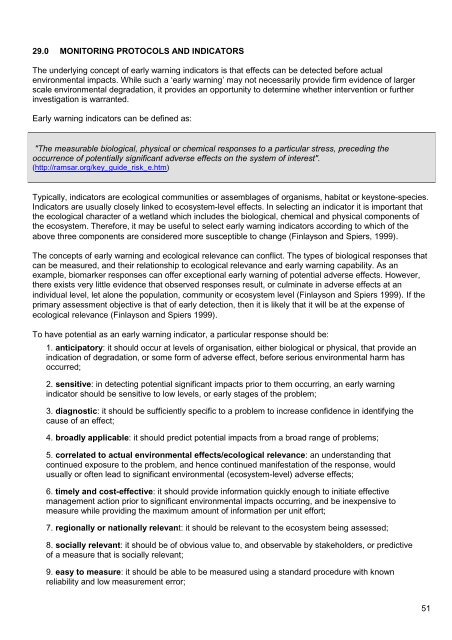Step 2 - Identification of <strong>the</strong> adverse effects. This step evaluates <strong>the</strong> likely extent of adverse change orimpact on <strong>the</strong> wetland. Such data should preferably be derived from field studies, as field data are moreappropriate <strong>for</strong> assessments of multiple impacts, such as occur on many wetlands. Depending on <strong>the</strong>extent of adverse change and available resources, such studies can range from quantitative fieldexperiments to qualitative observational studies. For chemical impacts, on-site ecotoxicological bioassaysconstitute appropriate approaches, whereas <strong>for</strong> changes caused by weeds or feral animals, on-siteobservation and mapping may be all that is required.Step 3 - Identification of <strong>the</strong> extent of <strong>the</strong> problem. This step estimates <strong>the</strong> likely extent of <strong>the</strong> problem on<strong>the</strong> wetland of concern by using in<strong>for</strong>mation ga<strong>the</strong>red about its behaviour and extent of occurrenceelsewhere. In <strong>the</strong> case of a chemical impact, this includes in<strong>for</strong>mation on processes such as transport,dilution, partitioning, persistence, degradation, and trans<strong>for</strong>mation, in addition to general chemicalproperties and data on rates of chemical input into <strong>the</strong> environment. In <strong>the</strong> case of an invasive weed, itmight include detailed in<strong>for</strong>mation on its entry into an ecosystem, rate of spread and habitat preferences.While field surveys most likely represent <strong>the</strong> ideal approach, use of historical records, simulation modeling,and field and/or laboratory experimental studies all represent alternative or complementary methods ofcharacterising <strong>the</strong> extent of <strong>the</strong> problem.Step 4 - Identification of <strong>the</strong> risk. This involves integration of <strong>the</strong> results from <strong>the</strong> assessment of <strong>the</strong> likelyeffects with those from <strong>the</strong> assessment of <strong>the</strong> likely extent of <strong>the</strong> problem, in order to estimate <strong>the</strong> likelylevel of adverse ecological change on <strong>the</strong> wetland. A range of techniques exist <strong>for</strong> estimating risks, oftendepending on <strong>the</strong> type and quality of <strong>the</strong> likely effects and <strong>the</strong>ir extent. A potentially useful technique <strong>for</strong>characterising risks in wetlands is via a GIS-based framework, whereby <strong>the</strong> results of <strong>the</strong> variousassessments are overlaid onto a map of <strong>the</strong> region of interest in order to link effects to impact. In addition toestimating risks, such an approach would also serve to focus future assessments and/or monitoring onidentified problem areas.Step 5 - Risk management and reduction. This is <strong>the</strong> final decision-making process and uses <strong>the</strong>in<strong>for</strong>mation obtained from <strong>the</strong> assessment processes described above, and it attempts to minimize <strong>the</strong> riskswithout compromising o<strong>the</strong>r societal, community or environmental values. In <strong>the</strong> context of <strong>the</strong> RamsarConvention, risk management must also consider <strong>the</strong> concept of wise use and <strong>the</strong> potential effects ofmanagement decisions on this. The result of <strong>the</strong> risk assessment is not <strong>the</strong> only factor that riskmanagement considers; it also takes into account political, social, economic, and engineering/ technicalfactors, and <strong>the</strong> respective benefits and limitations of each risk-reducing action. It is a multidisciplinary taskrequiring communication between site managers and experts in relevant disciplines.Step 6 - Monitoring. Monitoring is <strong>the</strong> last step in <strong>the</strong> risk assessment process and should be undertaken toverify <strong>the</strong> effectiveness of <strong>the</strong> risk management decisions. It should incorporate components that functionas a reliable early warning system, detecting <strong>the</strong> failure or poor per<strong>for</strong>mance of risk management decisionsprior to serious environmental harm occurring. The risk assessment will be of little value if effectivemonitoring is not undertaken. The choice of endpoints to measure in <strong>the</strong> monitoring process is critical.Fur<strong>the</strong>r, a GIS-based approach will most likely be a useful technique <strong>for</strong> wetland risk assessment, as itincorporates a spatial dimension that is useful <strong>for</strong> monitoring adverse impacts on wetlands.50
29.0 MONITORING PROTOCOLS AND INDICATORSThe underlying concept of early warning indicators is that effects can be detected be<strong>for</strong>e actualenvironmental impacts. While such a ‘early warning’ may not necessarily provide firm evidence of largerscale environmental degradation, it provides an opportunity to determine whe<strong>the</strong>r intervention or fur<strong>the</strong>rinvestigation is warranted.Early warning indicators can be defined as:"The measurable biological, physical or chemical responses to a particular stress, preceding <strong>the</strong>occurrence of potentially significant adverse effects on <strong>the</strong> system of interest".(http://ramsar.org/key_guide_risk_e.htm)Typically, indicators are ecological communities or assemblages of organisms, habitat or keystone-species.Indicators are usually closely linked to ecosystem-level effects. In selecting an indicator it is important that<strong>the</strong> ecological character of a wetland which includes <strong>the</strong> biological, chemical and physical components of<strong>the</strong> ecosystem. There<strong>for</strong>e, it may be useful to select early warning indicators according to which of <strong>the</strong>above three components are considered more susceptible to change (Finlayson and Spiers, 1999).The concepts of early warning and ecological relevance can conflict. The types of biological responses thatcan be measured, and <strong>the</strong>ir relationship to ecological relevance and early warning capability. As anexample, biomarker responses can offer exceptional early warning of potential adverse effects. However,<strong>the</strong>re exists very little evidence that observed responses result, or culminate in adverse effects at anindividual level, let alone <strong>the</strong> population, community or ecosystem level (Finlayson and Spiers 1999). If <strong>the</strong>primary assessment objective is that of early detection, <strong>the</strong>n it is likely that it will be at <strong>the</strong> expense ofecological relevance (Finlayson and Spiers 1999).To have potential as an early warning indicator, a particular response should be:1. anticipatory: it should occur at levels of organisation, ei<strong>the</strong>r biological or physical, that provide anindication of degradation, or some <strong>for</strong>m of adverse effect, be<strong>for</strong>e serious environmental harm hasoccurred;2. sensitive: in detecting potential significant impacts prior to <strong>the</strong>m occurring, an early warningindicator should be sensitive to low levels, or early stages of <strong>the</strong> problem;3. diagnostic: it should be sufficiently specific to a problem to increase confidence in identifying <strong>the</strong>cause of an effect;4. broadly applicable: it should predict potential impacts from a broad range of problems;5. correlated to actual environmental effects/ecological relevance: an understanding thatcontinued exposure to <strong>the</strong> problem, and hence continued manifestation of <strong>the</strong> response, wouldusually or often lead to significant environmental (ecosystem-level) adverse effects;6. timely and cost-effective: it should provide in<strong>for</strong>mation quickly enough to initiate effectivemanagement action prior to significant environmental impacts occurring, and be inexpensive tomeasure while providing <strong>the</strong> maximum amount of in<strong>for</strong>mation per unit ef<strong>for</strong>t;7. regionally or nationally relevant: it should be relevant to <strong>the</strong> ecosystem being assessed;8. socially relevant: it should be of obvious value to, and observable by stakeholders, or predictiveof a measure that is socially relevant;9. easy to measure: it should be able to be measured using a standard procedure with knownreliability and low measurement error;51
















